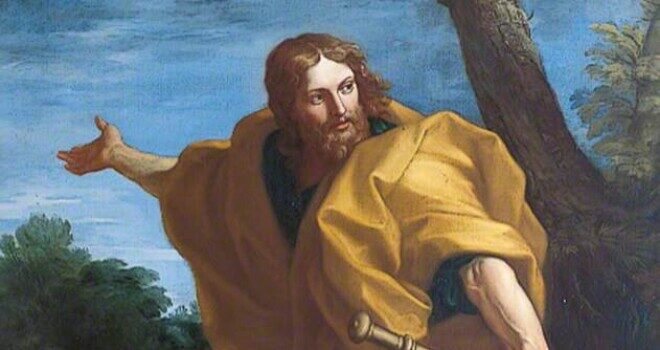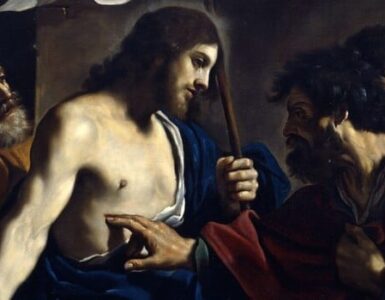James, the son of Zebedee and brother of John the Apostle, one of the first disciples of Jesus, was a fiery personality completely committed to the Great Commission. He was also the first martyr of Jesus’ disciples. His zeal bore the weight of sacrifice.
The Gospels tell a story about the disciples and Jesus. Early in His ministry, Jesus was preaching to listeners near Capernaum, a place of fisherman, about the Kingdom of God. Among the listeners were two young men, James and John, the sons of a fisher named Zebedee. Jesus preached from a fishing boat owned by Simon Peter, who, with his brother Andrew, were fishers as well and likely engaged in business with the Zebedees.
After Jesus spoke, He asked Peter to take the boat further out into the lake. Peter had spent some time with Jesus, even had had Him at his house, and though the fishers had fished the previous night without success, Peter complied with the request. Once out at sea, the fishers lowered their nets and to their astonishment there was such a catch that it threatened the sturdiness of the nets, even threatening the stability of the boat.
The Zebedee brothers witnessed the miracle and brought their boat alongside Peter’s and lowered their nets, which immediately filled with fish as well. Peter, now afraid, asked the Lord to depart.
The Gospels do not record the reaction of the Zebedee brothers, but we can gather from their subsequent relationship with Jesus what might have been their response. One of the brothers, John, became the “beloved disciple,” the apostle closest to Jesus. John recognized Jesus early on as the Christ, but more, the Wisdom of God, the Word, the Logos who was with God in the beginning of time. We might assume that his brother James had somewhat the same intuitive understanding.
Not only had James witnessed the miracle of the fish, but he was with Peter and John on the mount when Jesus was transfigured. He was with Jesus the many times that He healed the physically and mentally ill. On one occasion, at a synagogue, a possessed man demanded to know what Jesus wanted from him, crying out that he knew Jesus was the “holy one of God.” Furthermore, James listened to the parables and sermons, hearing words so forcefully put, so astonishingly truthful, that his faith was solidified; he knew this was the Christ.
James, along with his brother John, had learned that Jesus, a craftsman from Nazareth, knew people, really knew them—their past and future, their suspicions and problems. What is more, the miracle of the fish informed James that this man not only knew each human, but each creature as well: how else would he know where schools of fish were located in the lake? Thus, James and John came to know that Jesus was not only the long-anticipated Messiah but the eternal spoken and written Truth, the Logos. Jesus was, and is, God become flesh.
About the particulars of James’ life, little is known. He is rarely mentioned in the Gospels, though his presence is implied in the major actions of Jesus’ ministry. His mother, according to Matthew (27:56), was present at the crucifixion, as was his brother John. Mark (15:40) says that James’ mother was Salome, wife of Zebedee. John (19:25) implies that Salome was Mary’s sister, which if true, would mean that Jesus and James were cousins. Salome, if Jesus’ aunt, was sufficiently audacious to request of Jesus that her sons James and John be granted the privilege of sitting next to him in Heaven. Jesus responded that only if they could drink from His cup of suffering. Their willingness to do so explains Jesus’ nickname for the two brothers, the “Sons of Thunder.” James’ willingness and fervor explains his early martyrdom.
James was executed in 44 AD by Herod’s grandson, Herod Antipas, who ruled a large territory under the Roman emperors Caligula and Claudius, including Judaea and Samaria. Antipas was obsequious to the Romans as well as the Jews; hence, he was a persecutor of Christians, and for an unknown reason had James beheaded, as recorded in the Book of Acts (12:2).
Anecdotal evidence suggests that at some point between the Crucifixion and his own death, James evangelized as far as west Spain. Because of this, his remains are at the Cathedral of Santiago de Compostela in northwestern Spain.
Maratta, C. (1661). Saint James the Greater [painting]. Retrieved from ArtUK.
Catholic Encyclopedia: St. James the Greater. (n.d.). New Advent. https://www.newadvent.org/cathen/08279b.htm.











